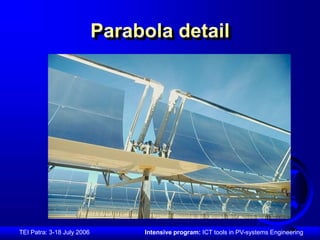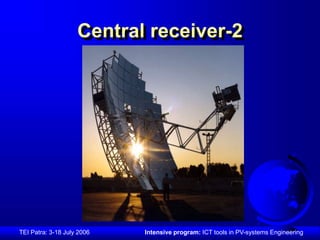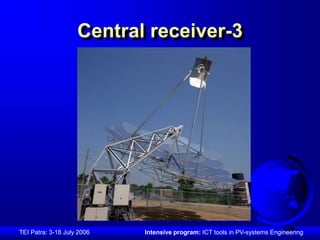This document discusses different types of concentrating solar collectors that can achieve higher temperatures than flat plate collectors. It describes four main types: parabolic trough systems, parabolic dish/engine systems, power tower systems, and stationary concentrating collectors. For each type it provides details on how it works, temperatures and efficiencies achieved, examples of implementations, and comparisons of features.




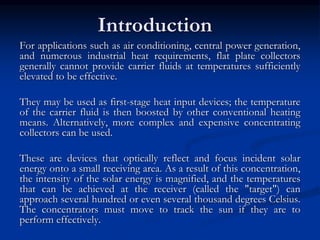
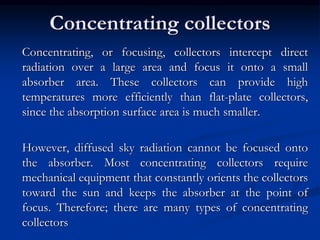

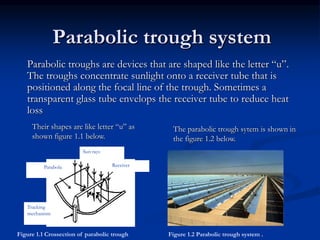


![Temperatures at the receiver can reach 400 °C and produce
steam for generating electricity. In California, multi-megawatt
power plants were built using parabolic troughs combined with
gas turbines
Parabolic trough combined with gas turbines is shown figure
1.5 below.
Figure 1.5 Parabolic trough combined with gas turbines [4].](https://image.slidesharecdn.com/solarppt-140822042232-phpapp02/85/Solar-Power-11-320.jpg)

![Mirror Strip (or)Parabolic
dish systems
A parabolic dish collector is similar in appearance to a large
satellite dish, but has mirror-like reflectors and an absorber
at the focal point. It uses a dual axis sun tracker .
Figure 2.2 Parabolic dish collector with a mirror-like
reflectors and an absorber at the focal point [Courtesy of
SunLabs - Department of Energy]
The below figure 2.1 shows crossection
of parabolic dish.
Figure 2.1 Crossection of parabolic dish .
The Parabolic dish collector is shown in
the below figure 2.2.](https://image.slidesharecdn.com/solarppt-140822042232-phpapp02/85/Solar-Power-13-320.jpg)

![Engines currently under consideration include Stirling and
Brayton cycle engines. Several prototype dish/engine systems,
ranging in size from 7 to 25 kW have been deployed in
various locations in the USA. High optical efficiency and low
start up losses make dish/engine systems the most efficient of
all solar technologies. A Stirling engine/parabolic dish system
holds the world’s record for converting sunlight into
electricity. In 1984, a 29% net efficiency was measured at
Rancho Mirage, California ].](https://image.slidesharecdn.com/solarppt-140822042232-phpapp02/85/Solar-Power-15-320.jpg)
![3.3. Power tower system
A heliostat uses a field of dual axis sun trackers that direct solar
energy to a large absorber located on a tower. To date the only
application for the heliostat collector is power generation in a
system called the power tower .
Heliostats are shown in the
figure below.
Figure 3.3.1 Power tower system [4]. Figure 3.3.2 Heliostats [4].](https://image.slidesharecdn.com/solarppt-140822042232-phpapp02/85/Solar-Power-16-320.jpg)
![A power tower has a field of large mirrors that follow the sun's
path across the sky. The mirrors concentrate sunlight onto a
receiver on top of a high tower. A computer keeps the mirrors
aligned so the reflected rays of the sun are always aimed at the
receiver, where temperatures well above 1000°C can be
reached. High-pressure steam is generated to produce
electricity [3].
The power tower system with heliostats is shown in the figure
3.3.3 below.
Figure 3.3.3 Power tower system with heliostats [4].](https://image.slidesharecdn.com/solarppt-140822042232-phpapp02/85/Solar-Power-17-320.jpg)
![3.4. Stationary concentrating
solar collectors
Stationary concentrating collectors use compound parabolic
reflectors and flat reflectors for directing solar energy to an
accompanying absorber or aperture through a wide acceptance
angle. The wide acceptance angle for these reflectors eliminates
the need for a sun tracker. This class of collector includes
parabolic trough flat plate collectors, flat plate collectors with
parabolic boosting reflectors, and solar cooker. Development of
the first two collectors has been done in Sweden. Solar cookers
are used throughout the world, especially in the developing
countries [3].](https://image.slidesharecdn.com/solarppt-140822042232-phpapp02/85/Solar-Power-18-320.jpg)

![4.1. Trough Systems
These solar collectors use mirrored parabolic troughs to focus the
sun's energy to a fluid-carrying receiver tube located at the focal
point of a parabolically curved trough reflector [5].It is shown in
the figure 4.1.1 below.
Figure 4.1.1 Parabolic trough with mirrored parabolic troughs [10].](https://image.slidesharecdn.com/solarppt-140822042232-phpapp02/85/Solar-Power-20-320.jpg)

![Trough designs can incorporate thermal storage-setting aside
the heat transfer fluid in its hot phase allowing for electricity
generation several hours into the evening. Currently, all
parabolic trough plants are "hybrids," meaning they use fossil
fuels to supplement the solar output during periods of low
solar radiation. Typically, a natural gas-fired heat or a gas
steam boiler/reheater is used. Troughs also can be integrated
with existing coal-fired plants [5].](https://image.slidesharecdn.com/solarppt-140822042232-phpapp02/85/Solar-Power-22-320.jpg)

![Each dish produces 5 to 50 kW of electricity and can be used
independently or linked together to increase generating
capacity. A 250-kW plant composed of ten 25-kW
dish/engine systems requires less than an acre of land.
Dish/engine systems are not commercially available yet,
although ongoing demonstrations indicate good potential.
Individual dish/engine systems currently can generate about
25 kW of electricity. More capacity is possible by connecting
dishes together. These systems can be combined with natural
gas, and the resulting hybrid provides continuous power
generation [5].
Figure 4.2.1 Combination of parabolic dish system [4].
The right figure 4.2.1 shows
the combination of parabolic
dish system.](https://image.slidesharecdn.com/solarppt-140822042232-phpapp02/85/Solar-Power-24-320.jpg)
![4.3. Central Receiver Systems
Central receivers (or power towers) use thousands of individual
sun-tracking mirrors called "heliostats" to reflect solar energy
onto a receiver located on top of tall tower. The receiver
collects the sun's heat in a heat-transfer fluid (molten salt) that
flows through the receiver. The salt's heat energy is then used to
make steam to generate electricity in a conventional steam
generator, located at the foot of the tower. The molten salt
storage system retains heat efficiently, so it can be stored for
hours or even days before being used to generate electricity [5].
In this system, molten-salt is pumped from a “cold” tank at 288
deg.C and cycled through the receiver where it is heated to 565
deg.C and returned to a “hot” tank. The hot salt can then be
used to generate electricity when needed. Current designs allow
storage ranging from 3 to 13 hours [4].](https://image.slidesharecdn.com/solarppt-140822042232-phpapp02/85/Solar-Power-25-320.jpg)
![Figure 4.3.1 shows the process of molten salt storage.
Figure 4.3.1 The process of molten salt storage [11].](https://image.slidesharecdn.com/solarppt-140822042232-phpapp02/85/Solar-Power-26-320.jpg)

![The modular nature of dishes will allow them to be used in
smaller, high-value applications. Towers and dishes offer the
opportunity to achieve higher solar-to-electric efficiencies and
lower cost than parabolic trough plants, but uncertainty remains as
to whether these technologies can achieve the necessary capital
cost reductions and availability improvements. Parabolic troughs
are currently a proven technology primarily waiting for an
opportunity to be developed. Power towers require the operability
and maintainability of the molten-salt technology to be
demonstrated and the development of low cost heliostats.
Dish/engine systems require the development of at least one
commercial engine and the development of a low cost
concentrator [4].](https://image.slidesharecdn.com/solarppt-140822042232-phpapp02/85/Solar-Power-28-320.jpg)
![Highlights the key features of the three solar technologies.
Parabolic Trough Dish/Engine Power Tower
Size 30-320 MW 5-25 kW 10-200 MW
Operating Temperature
(ºC/ºF)
390/734 750/1382 565/1049
Annual Capacity Factor 23-50 % 25 % 20-77 %
Peak Efficiency 20%(d) 29.4%(d) 23%(p)
Net Annual Efficiency 11(d)-16% 12-25%(p) 7(d)-20%
Commercial Status
Commercially Scale-up
Prototype
Demonstration AvailableDemonstration
Technology
Development Risk
Low High Medium
Storage Available Limited Battery Yes
Hybrid Designs Yes Yes Yes
Cost USD/W 2,7-4,0 1,3-12,6 2,5-4,4
(p) = predicted; (d) = demonstrated;
Table 5.1 Key features of the three solar technologies [4].](https://image.slidesharecdn.com/solarppt-140822042232-phpapp02/85/Solar-Power-29-320.jpg)

![Commercial applications from a few kilowatts to hundreds of
megawatts are now feasible, and plants totaling 354 MW have
been in operation in California since the 1980s. Plants can
function in dispatchable, grid-connected markets or in
distributed, stand-alone applications. They are suitable for fossil-hybrid
operation or can include cost-effective storage to meet
dispatchability requirements. They can operate worldwide in
regions having high beam-normal insolation, including large areas
of the southwestern United States, and Central and South
America, Africa, Australia, China, India, the Mediterranean
region, and the Middle East, . Commercial solar plants have
achieved levelized energy costs of about 12-15¢/kWh, and the
potential for cost reduction are expected to ultimately lead to
costs as low as 5¢/kWh [6].](https://image.slidesharecdn.com/solarppt-140822042232-phpapp02/85/Solar-Power-31-320.jpg)

![Following a subsidised introduction phase in green markets,
electricity costs will decrease from 14 to 18 Euro cents per
kilowatt hour presently in Southern Europe towards 5 to 6
Euro cents per kilowatt hour in the near future at good sites
in the countries of the Earth’s sunbelt. After that, there will
be no further additional cost in the emission reduction by
CSP. This, and the vast potential for bulk electricity
generation, moves the goal of longterm stabilisation of the
global climate into a realistic range. Moreover, the problem of
sustainable water resources and development in arid regions
is addressed in an excellent way, making use of highly
efficient, solar powered co-generation systems. However,
during the introduction phase, strong political and financial
support from the responsible authorities is still required, and
many barriers must be overcome [7].](https://image.slidesharecdn.com/solarppt-140822042232-phpapp02/85/Solar-Power-33-320.jpg)
![References
[1]http://aloisiuskolleg.www.de/schule/fachber
eiche/comenius/charles/solar.html
[2]http://www.tpub.com/utilities/index.html
[3]http://www.canren.gc.ca/tech.appl/index.asp](https://image.slidesharecdn.com/solarppt-140822042232-phpapp02/85/Solar-Power-34-320.jpg)






